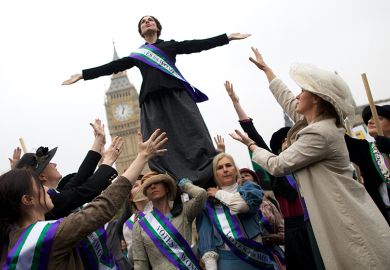Since she is perhaps the most influential and widely travelled feminist in the Western academy, there are few gender theorists who have not encountered Judith Butler. I certainly have, and I benefited greatly from her insights and encouragement when grappling with her ever more capacious philosophical reasoning. However, this never strays far from passionate engagement with pressing political and moral matters of the moment, addressing people’s unequal exposure to violence and abandonment, which is why Butler is also well known in activist circles.
One question sometimes asked nowadays is how far she has strayed from the text that launched her enduring academic celebrity, Gender Trouble (1990), which theorised the contingent nature of gender as a set of repetitive, performative social and historical practices. If we read carefully, the answer is at least partially clarified in this latest text, The Force of Nonviolence, which firms up her thoughts on violence and collective resistance developed over the past two decades, especially since American responses to 9/11 in 2001. Here we find those early thoughts stemming from her interrogation of how coercive gender norms erase the lives of those outside their normative heterosexual framing increasingly fanning out to examine a profusion of coercive norms rendering ever more populations invisible and forsaken. Butler has been analysing the annihilating effects of such demographic repudiations at least since Precarious Lives: The Power of Mourning and Violence (2004), which surveys the particular populations whose situations are increasingly rendered unliveable, their deaths ungrievable, especially in these times of global precarity and warfare. These now include 10 million stateless people.
The contention that Butler’s words have always provoked is bound to continue with this new book, since challenges to accepted norms and automatic assumptions are always likely to provoke rage. This is what Butler’s formidable journey has been about all along, as she carefully, with assertive toughness, combats the hatred, fear and rage of those who respond violently to her continuous commitment to confronting normative patterns of coercion with calls for concerted actions of resistance. Expanding on her earlier interest in psychoanalysis, Butler founds her theorising of violence on the claim that we are all from the beginning mired in ambivalence and aggression, yet she argues that this is precisely what creates the possibility (in her view the necessity) of a commitment to non-violence. However, such a commitment arises when, and only when, we acknowledge our shared entanglement in violence, along with its powerful corollary – recognition of the shared vulnerability and interdependence of all living things. Moreover, populations, however repudiated, can never simply be reduced to their vulnerability, nor their vulnerability to passivity. This is despite so many who are seemingly marked for dispossession and death today, including the tens of thousands who die annually seeking refuge in Europe and the 3,000 women killed annually in Latin America alone – including large numbers of trans women.
Ever the semantic sleuth, Butler knows only too well that the terms “violence” and “non-violence” are used instrumentally, serving as much to justify and conceal as to describe and reveal practices of harm and injury. We habitually see violence as interpersonal, physical assault, thereby discounting the structural, systemic violence of racism, class exploitation, sexism and all those other forms of disregard or contempt responsible for daily injury and neglect. Accordingly, routine practices of violence regularly go unnamed, even as resistance to such disavowed injury and neglect is itself labelled violent – usually by the very same states and institutions that have failed in their supposed mandate to keep their inhabitants free from violence and neglect. We see such misappropriation everywhere. In Turkey in 2016, for example, those signing a petition for peace were found guilty of an act of violence. So, too, in relation to Israel, the practice of non-violent boycotts, divestment and sanctions (BDS) used to highlight the routine killings and injuries of occupation is often condemned as a politics of violence.
Thinking with and beyond one of her many mentors, Walter Benjamin, Butler asks: “Can violence and nonviolence both be thought beyond the instrumentalist framework, and what new possibilities for ethical and political critical thought result from that opening?” She takes her stance from the simple assertion that, since violence is always with us, when any one of us commits acts of violence we are thereby primarily helping to build a more violent world – any use of violence licenses further violence. Nevertheless, Butler is clear that it is only via continuous commitment to an egalitarian imaginary that we can first understand and then try to turn around the potential for violence that inheres in all social bonds and individuals alike. We must begin with an encouragement for us all to recognise, rather than disavow, our need of protection from the harm and destruction we are capable of unleashing, especially towards those who have been discursively targeted as valueless.
The challenge remains how to translate these thoughts into collective resistance on diverse fronts. Butler is most immediately persuasive when addressing systemic racism in the US, intrinsic to the country from its inception and often amounting to a form of “race-war”, in which those whose lives are most threatened are habitually labelled perpetrators of violence: “the black man is simply there, vulnerable to being killed, and so he is killed, as if he is prey and the police are hunters”. Similarly, black women have been incarcerated for defending themselves against sexual assault. But Butler shows that this practice of negating and inverting violence also targets queer or transgendered people, disposable women and migrants in search of asylum in Europe, who are equally named as threatening, vulnerable to abandonment and death, their unregistered lives ungrieved.
This means that any consistent politics of non-violence must always be conjoined with relentless critical exposure of norms that separate those lives that count as liveable and grievable from those that do not, while moving beyond all human life towards preserving the world itself. This is why Black Lives Matter remains such an exemplary form of critical resistance, as is Ni Una Menos, started by a collective in Argentina, which has mobilised more than a million women across Latin America and well beyond. They both confront the climate of fear surrounding those whose lives and identities are fundamentally unprotected, killed with impunity, in what amounts to necropolitical targeting.
Some have criticised Butler’s recent work on non-violence as being a replacement of politics by an ethical turn to humanism. She rejects this, I think rightly, describing her analysis as less a moral stance than a sustained and concerted political confrontation. This form of resistance arises from the rage and indignation necessary to combat inequality in all its manifestations, whether intrinsic to racism, xenophobia, homophobia, misogyny or any of the ways people are rendered dispensable by failing infrastructures of care at every level. As she says, the political power of non-violence is precisely its exposure of and resistance to the ruses by which systemic violence hides its true nature, enabling the destruction of all who threaten existing hierarchies of privilege and protection, as we try to nurture those open-ended, always tenuous solidarities insisting that all lives can and must be equally valued.
This is why Butler is adamant that neither non-violence nor vulnerability equate with passivity, but instead can help foster resistance. Indeed to equate them with passivity takes us back to that normative gendered division of attributes, linking masculinity to activity, and femininity to passivity, which has served all along to coercively restrain or deny the liveability of those who transgress this binary. Thus we return to where Butler began, making gender trouble in the academy. Who knew how far it would take her?
Lynne Segal is anniversary professor of psychology and gender studies at Birkbeck, University of London and the author, most recently, of Radical Happiness: Moments of Collective Joy (2017).
The Force of Nonviolence: The Ethical in the Political
By Judith Butler
Verso, 224pp, £14.99
ISBN 9781788732765
Published 4 February 2020
The author
Judith Butler, Maxine Elliot professor in the department of comparative literature and the programme of critical theory at the University of California, Berkeley, was born in Cleveland, Ohio and studied at Bennington College before moving on to Yale University for a degree in philosophy followed by a PhD. She spent a year at Heidelberg University as a Fulbright Scholar and later had fellowships at both the Institute for Advanced Study at Princeton and the École Normale Superiéure in Paris.
Before joining Berkeley in 1993, Butler had teaching positions at Wesleyan University, George Washington University and Johns Hopkins University. She is now also the Hannah Arendt chair at the European Graduate School in Saas-Fee, Switzerland.
Although she started her career with books such as Subjects of Desire: Hegelian Reflections in Twentieth-Century France (1987), Butler achieved much greater fame with Gender Trouble: Feminism and the Subversion of Identity (1990), widely regarded as a central text in queer and feminist theory for its analysis of the ways in which gender is performed. She followed this up with Bodies That Matter: On the Discursive Limits of “Sex” (1993).
Prominent in organisations such as the Center for Constitutional Rights in New York and on the advisory board of Jewish Voice for Peace, Butler has focused much of her recent work on broad issues of human rights and Israel-Palestine. Her major books on these themes include The Psychic Life of Power: Theories of Subjection (1997), Precarious Life: The Powers of Mourning and Violence (2004), Frames of War: When Is Life Grievable? (2009) and Parting Ways: Jewishness and the Critique of Zionism (2012). Among many other honours, she was invited to deliver the Watts Lecture at the Nobel Museum in Stockholm and the annual Freud Lecture at the Freud Museum in Vienna. In 2014, the French Culture Ministry made her a Chevalier of the Order of Arts and Letters.
Matthew Reisz
POSTSCRIPT:
Print headline: Raging against our savage side
Register to continue
Why register?
- Registration is free and only takes a moment
- Once registered, you can read 3 articles a month
- Sign up for our newsletter
Subscribe
Or subscribe for unlimited access to:
- Unlimited access to news, views, insights & reviews
- Digital editions
- Digital access to THE’s university and college rankings analysis
Already registered or a current subscriber?







